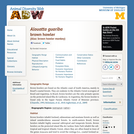
Alouatta fusca: Information
- Subject:
- Life Science
- Zoology
- Material Type:
- Reading
- Provider:
- University of Michigan Museum of Zoology
- Provider Set:
- Animal Diversity Web
- Author:
- Carl Flink (author), University of Michigan
- Date Added:
- 03/07/2005

Alouatta fusca: Information
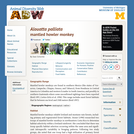
Alouatta palliata: Information
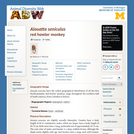
Alouatta seniculus: Information

Animal fact sheet
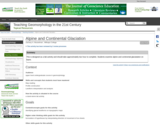
This activity follows a discussion in lecture about how to recognize various types of glacial landforms created through both erosional and depositional processes. It gives students practive in reading maps, interpreting landforms and synthesizing various types of landscapes.
Designed for a geomorphology course
Has minimal/no quantitative component
(Note: this resource was added to OER Commons as part of a batch upload of over 2,200 records. If you notice an issue with the quality of the metadata, please let us know by using the 'report' button and we will flag it for consideration.)

This resource is a video abstract of a research paper created by Research Square on behalf of its authors. It provides a synopsis that's easy to understand, and can be used to introduce the topics it covers to students, researchers, and the general public. The video's transcript is also provided in full, with a portion provided below for preview:
"Certain gut microbes and their metabolites contribute to the progression of benign colorectal adenoma (CRA) into colorectal cancer (CRC), but the specific microbes, metabolites, and mechanisms involved are unclear. To learn more, researchers recently analyzed stool samples from patients with CRA or CRC and normal control (NC) subjects. The levels of certain stool metabolites significantly differed among the groups. For example, myristic acid and norvaline became more abundant with progression from health to CRC. The CRC-associated metabolites were largely branched- chain amino acids and aromatic amino acids and were involved in aminoacyl-tRNA biosynthesis pathways. A metabolite “signature” distinguished CRC samples from NC samples and CRC samples from CRA samples and the relationships among CRC-related metabolites and gut bacteria differed in the different sample types..."
The rest of the transcript, along with a link to the research itself, is available on the resource itself.

This resource is a video abstract of a research paper created by Research Square on behalf of its authors. It provides a synopsis that's easy to understand, and can be used to introduce the topics it covers to students, researchers, and the general public. The video's transcript is also provided in full, with a portion provided below for preview:
"Autophagy is an important cellular recycling process that degrades misfolded proteins and damaged organelles. In typical (“canonical”) autophagy, membranes derived from the endoplasmic reticulum surround damaged materials that need to be degraded, and the proteins Atg5 and Atg7 help form specialized digestion compartments (autophagosomes), but another type of autophagy, called alternative autophagy, was recently discovered. In alternative autophagy, the membranes that envelop the damaged materials are derived from the trans-Golgi membrane, and Atg5 and Atg7 do not participate in autophagosome formation. Alternative autophagy seems to be activated primarily under conditions of cell stress, and it plays roles in many diseases, such as heart disease, neurodegenerative disease, cancer, inflammatory bowel disease, and bacterial infection..."
The rest of the transcript, along with a link to the research itself, is available on the resource itself.
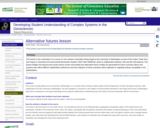
Alternative futures studies are a valuable yet resource-intensive way in which environmental scientists try to conduct informed debates about policies for specific geographic regions. These studies require modeling what the future would look like if different stakeholder groups had their way. The modeling is carried out by applying historical trend data to future projections that are rooted in the preferences of the different groups. Alternative future studies can be controversial due to the limitations of modeling and to the extent to which the models represent fully the different possible scenarios. Yet, they can be especially valuable for decision making about which areas in the region would be most appropriate and most acceptable for the applications of different policies such as development and restoration. Through a series of hands-on classroom activities that are the culmination of a variety of field trips, case studies, and analyses of GIS data about river systems and river restoration options, the students build deep understanding about what alternative futures studies entail and what are the applications of such studies to specific rivers in the Puget Sound area.
(Note: this resource was added to OER Commons as part of a batch upload of over 2,200 records. If you notice an issue with the quality of the metadata, please let us know by using the 'report' button and we will flag it for consideration.)

This resource is a video abstract of a research paper created by Research Square on behalf of its authors. It provides a synopsis that's easy to understand, and can be used to introduce the topics it covers to students, researchers, and the general public. The video's transcript is also provided in full, with a portion provided below for preview:
"The gut microbiome interacts intimately with its human host, both in health and in disease. A recent study examined how different states of the gut microbiome might be linked to varying degrees of disease in rats. Researchers exposed rats to different concentrations of dextran sodium sulfate (DSS), a polysaccharide known to induce human-like colitis. The effects on the intestinal microbiome over time were tracked by gene profiling. The results provide some of the first experimental evidence of “alternative states” in the rat intestinal ecosystem. These are distinct microbial profiles related to markers of disease. Importantly, these alternative states were found to be tied to both the host and microbiome, rather than one or the other. That led to a conceptual model of how host inflammatory status and microbiome status interact and how the whole ecosystem may slip into and out of different states of disease..."
The rest of the transcript, along with a link to the research itself, is available on the resource itself.

This resource is a video abstract of a research paper created by Research Square on behalf of its authors. It provides a synopsis that's easy to understand, and can be used to introduce the topics it covers to students, researchers, and the general public. The video's transcript is also provided in full, with a portion provided below for preview:
"Since its appearance in late 2019, COVID-19 has caused well over one million deaths worldwide. Large-scale testing and contact tracing remain critical for controlling viral spread. Complying with the US CDC and WHO protocols for sample collection requires a ready supply of inexpensive swabs and collection reagents. Unfortunately, CDC-approved clinical-grade sampling supplies are expensive, and additionally, current methods prevent further analysis of the microbiome due to the presence of antibiotics in viral transport media. Researchers sought out new testing supplies in a recent study comparing five consumer-grade swabs and one clinical-grade swab. They found that using 95% ethanol instead of viral transfer media reduced RNase activity, preserving samples for microbiome analysis, and extracting directly from the swab head instead of the surrounding liquid resulted in 2-4x higher RNA recovery than the clinical standard..."
The rest of the transcript, along with a link to the research itself, is available on the resource itself.

This video segment from the Secret of Life School Video: "Genetic Medicine: Tinkering with Our Genes" explores the potential for gene therapy to cure diseases like Alzheimer's.

This resource is a video abstract of a research paper created by Research Square on behalf of its authors. It provides a synopsis that's easy to understand, and can be used to introduce the topics it covers to students, researchers, and the general public. The video's transcript is also provided in full, with a portion provided below for preview:
"Glioma is the most common and lethal form of brain cancer. Among patients with the highest grade of glioma, fewer than 6% survive up to 5 years after diagnosis. Interestingly, glioma is extremely rare in one large population of patients patients with Alzheimer’s disease. That suggests that an anti-glioma molecule could play a critical role in the development of Alzheimer’s. In a recent study, researchers assessed one possible candidate: presenilin-1. Presenilin-1 is a protein that assists the formation of amyloid beta, the main component of the hallmark plaques found in the brains of patients with Alzheimer’s. Experiments showed that high presenilin-1 levels in glioma tissue from patients correlated with low tumor proliferation. Closer examination revealed that presenilin-1 kept cancer from spreading by preventing tumor cells from replicating their DNA. This mechanism could explain the poor prognosis of glioma patients with low levels of presenilin-1..."
The rest of the transcript, along with a link to the research itself, is available on the resource itself.

This resource is a video abstract of a research paper created by Research Square on behalf of its authors. It provides a synopsis that's easy to understand, and can be used to introduce the topics it covers to students, researchers, and the general public. The video's transcript is also provided in full, with a portion provided below for preview:
"There may be a silver lining for those at high risk for Alzheimer’s: as the chance of getting the disease goes up, certain treatments may become more effective. The risk of developing Alzheimer’s largely relies on a gene called APOE, with different variants conferring more or less risk. Usually, having a high-risk allele is bad news, but a group of researchers from New York University has reported that carrying the high-risk allele could actually boost responsiveness to immunotherapy, a promising new treatment option. The APOE gene helps determine how much beta-amyloid accumulates in the brain. Beta-amyloid starts as small misfolded bits of protein that clump together to form the plaques that are the hallmark of Alzheimer’s. As the plaques appear, the brain deteriorates, particularly in regions associated with memory. One way to potentially halt this process is to use antibodies that recognize beta-amyloid. The antibodies bind to the protein and signal to the immune system to clear it out..."
The rest of the transcript, along with a link to the research itself, is available on the resource itself.

This book by Kim Adelson for the Black Hills Audubon Society helps young children learn about different animals and their characteristics, and whether or not they are birds. Through colorful illustrations and engaging text, the book presents various animals and their habitats, and poses the question of whether or not they are birds. This book is a great resource for educators to introduce children to the world of birds and their unique features.
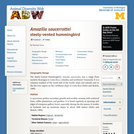
Amazilia saucerrottei: Information

Amazilia tzacatl: Information
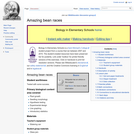
Developed for fifth grade and above. Primary biological content area covered:; Plant growth; Seedling morphology; Hypothesis testing; Experimental design; Line graphing; Introductory statistics.Biology In Elementary Schools is a Saint Michael's College student project. The teaching ideas on this page have been found, refined, and developed by students in a college-level course on the teaching of biology at the elementary level. Unless otherwise noted, the lesson plans have been tried at least once by students from our partner schools. This wiki has been established to share ideas about teaching biology in elementary schools. The motivation behind the creation of this page is twofold: 1. to provide an outlet for the teaching ideas of a group of college educators participating in a workshop-style course; 2. to provide a space where anyone else interested in this topic can place their ideas.
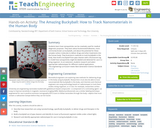
Students learn how nanoparticles can be creatively used for medical diagnostic purposes. They learn about buckminsterfullerenes, more commonly known as buckyballs, and about the potential for these complex carbon molecules to deliver drugs and other treatments into the human body. They brainstorm methods to track buckyballs in the body, then build a buckyball from pipe cleaners with a fluorescent tag to model how nanoparticles might be labeled and detected for use in a living organism. As an extension, students research and select appropriate radioisotopes for different medical applications.

Looking for a lesson for your younger students? This K-2nd grade lesson will allow students to investigate the three types of honey bees in a colony, identify their roles, and recognize honey bees as part of a community that works together. The lesson includes three activities, vocabulary words, recommended reading, and a "making honey" lab!
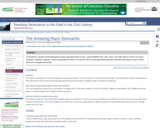
Students will learn how to perform basic skills using a Garmin GPS unit; mark waypoints, navigate to a waypoint, use the compass and 'go to' functions to estimate distance to a pre-programmed point, change GPS data to find hidden locations. Students will work in teams and help each other as they learn new GPS skills and gain a working understanding of georeferenced data, using clues and team work to solve problems, and how objects are oriented in space.
(Note: this resource was added to OER Commons as part of a batch upload of over 2,200 records. If you notice an issue with the quality of the metadata, please let us know by using the 'report' button and we will flag it for consideration.)